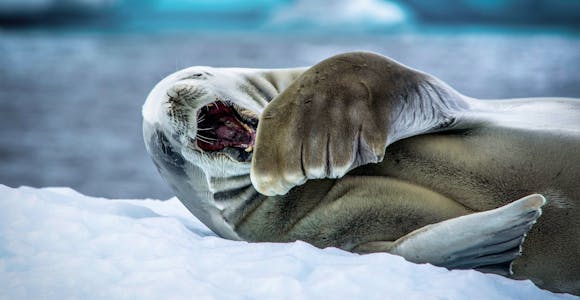
A guide to the seals of Antarctica
As both predators and prey, seals are key to the Antarctic ecosystem. Learn more about the five main species you’re likely to spot.
Discover MorePrice Match Promise-We’ll match any price you find elsewhere for the same trip
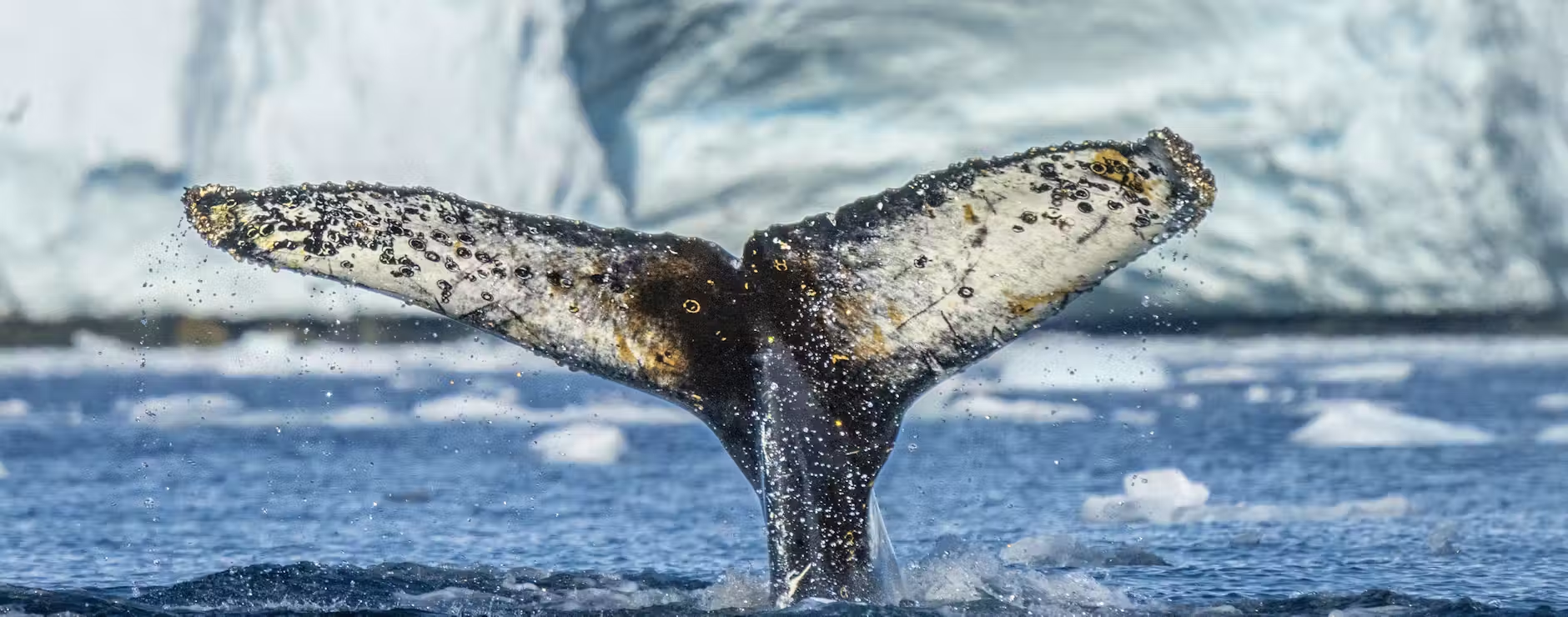
Witnessing whales in all their glory is a highlight of any adventure to Antarctica. Watch in wonder as these gentle giants swim and feed mere feet away or showcase their flukes as they dive nearby. Our guide is here to help you discover more about the whale species you might see, plus tips for catching sight of cetaceans.
One of the White Continent’s recent success stories is that you can spot whales here at all. Dubbed “floating gold”, blubber was in high demand by the start of the 20th Century – so much so, it led to the launch of commercial whaling in Antarctica in 1904.
While the International Whaling Commission finally introduced a moratorium on whaling in 1982, it wasn’t fully banned until 1986. Over the course of around 80 years, an estimated 1.3 million whales were killed in the Southern Ocean.
The good news? Decimated whale populations are returning from the brink. Humpbacks have shown a particularly strong recovery, with high annual increase rates of 7% to 12% recorded around the Antarctic.
Still, illegal whaling – sometimes in the name of “science” – and factors such as climate change mean the bounceback isn't guaranteed. Remnants of the Antarctic whaling industry, such as the rusting oil tanks still standing on Deception Island today, are an eerie reminder of the past. Yet they also serve as motivation for us to make sure the future of these giants of the sea stays secure for generations to come.
Did you know that Antarctica’s whales are ecosystem engineers for the world’s oceans?
Swoop Antarctica Expert Paul
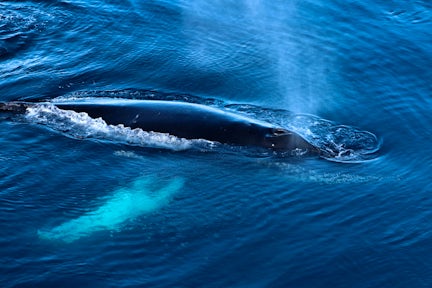
A humpback whale surfaces
Whale sightings are less frequent in the early part of the annual Antarctic visiting season, around November into December, as many species are still migrating south from the tropics. But you can sometimes spot early arrivals, especially humpbacks and minkes.
More whales find their way to Antarctic waters by January. Feeding intensifies, and sightings become more common.
February through to March, the end of the visiting season, offer the highest chance of encounters. By this time, whales are well fed after months of gorging on krill and sometimes become playful. Humpbacks and minkes, in particular, have been known to approach zodiac boats and kayaks out of curiosity.
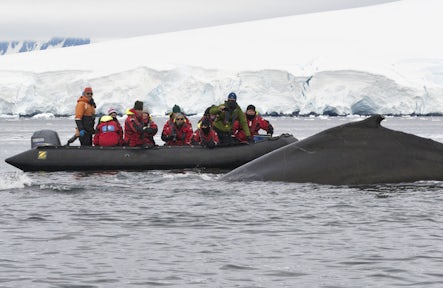
A whale approaches a zodiac © Mark Belding
Whale watching in Antarctica is all about letting nature take the lead. There’s no chasing or crowding – just incredible moments where you get to see these majestic creatures on their own terms.
Zodiac boats stick to IAATO guidelines, keeping a respectful 100-metre (328 ft) distance. But some whales, especially curious humpbacks, don’t always follow the rules. Every now and then, they’ll come right up to the boat – so close that you might even catch a whiff of their breath.
If your ship or zodiac is moving at a snail’s pace, you’re probably in a designated go-slow zone. These areas help keep the whales safe by reducing the risk of collisions and disturbances. Plus, they give you more time to soak up the experience.
Compared to places like Mexico, where grey whales are known for being especially interactive, Antarctic species can be a bit more reserved. But patience may pay off – especially in February and March, when they tend to get a little bolder. Whether it’s a surprise close encounter or just watching whales cruise by, every sighting feels like a privilege.

Diving humpback whale, Melchior Islands
Some travellers ask whether it’s safe to be in a zodiac boat near a whale. The short answer? Yes!
Zodiac drivers are highly experienced and trained to navigate safely around Antarctic wildlife, making sure not to disturb any animals. Whales are also highly aware of their surroundings and recognise boats in the water. If they start interacting with you, their behaviour will be curious rather than aggressive.
Rest assured, there are no known incidents where whales have disturbed zodiac boats in Antarctica.
Cruise ships actually help protect Antarctica's whales
Swoop Antarctica Expert Paul
Expedition teams will always look for good whale-watching opportunities, but keep in mind that your ship can't stop for every sighting. Some species, like fin whales – the "greyhounds of the sea" – travel fast and may not stick around. Other times, stopping could interfere with natural whale behaviour. But when the timing is right, once-in-a-lifetime encounters can happen.
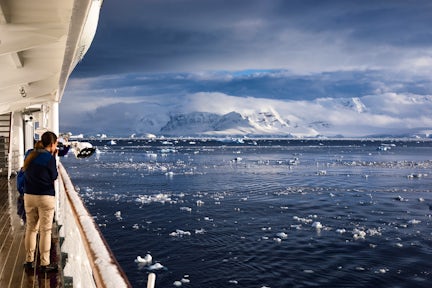
Looking out across the South Shetlands
For the best chance of spotting whales, spend as much time as possible out on deck. Often, both the ship and the whales are on the move, so opportunities can come and go quickly. Sometimes, whale activity is announced over the tannoy, but other times, the moment passes in a flash. Stay prepared by keeping your coat, gloves and camera nearby, and figure out the quickest route from your cabin to the deck early on in the expedition.
It can get cold out there, especially as you’re often standing still, so dress warmly in layers to make sure you can stay put for longer.
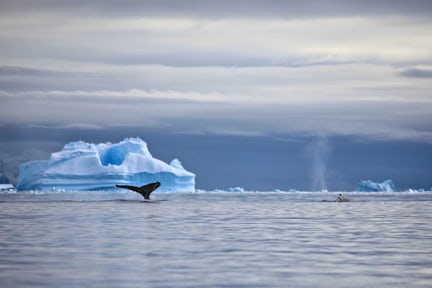
A whale dives in the distance
When on the lookout for whales, scan into the distance with your eyes, rather than your binoculars. Once you’ve got a possible sighting, use your binoculars or camera lens to zoom in for a closer look.
Watch the coastline for the more common humpbacks and minkes, and keep an eye out at sea for the much rarer fin whales and orcas. Once you spot one, there’s a good chance there are more nearby – whether because they’re travelling together or are simply drawn to the same area.
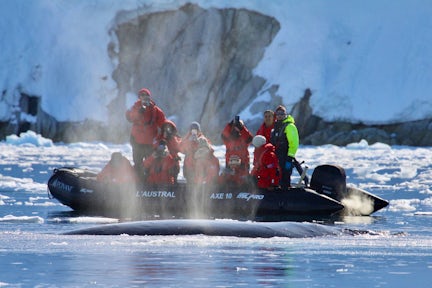
The blow of a humpback whale
A whale’s blow is unmistakable – once you’ve seen it, you’ll recognise it every time. Keep an eye on the water for that distinctive misty spout rising above the surface.
While being out on deck is the best place for whale watching, our team at Swoop have reported seeing blows from their cabins, the observation lounge and other vantage points on the ship. Once your eyes are trained, you’ll start noticing them everywhere.
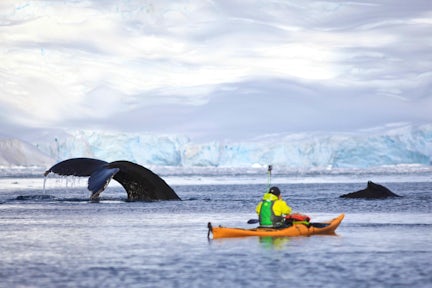
A jaw-dropping humpback encounter while kayaking
Whale blows aren’t just a sight to see. On still, windless days, you might hear the powerful exhalation of a whale’s breath, like the sudden release of pressure from a tyre. Some whales even have unusual, squeaky blows.
Hearing the noise of a whale is especially incredible when you're kayaking, as the lack of engine noise makes it even clearer.
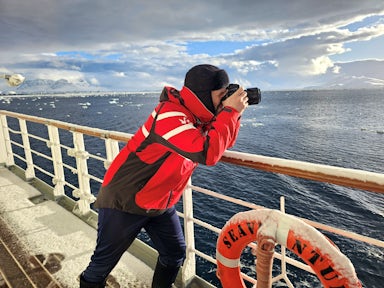
Zooming in on Antarctica from the deck
You’re not always guaranteed a close encounter with whales in Antarctica, so a zoom lens is essential if you're determined to capture the perfect photo. Just remember that getting the ideal framing and light with a moving object is tough. Instead of becoming frustrated, we recommend giving yourself time to enjoy the experience with your own eyes rather than through a lens.
Even if your photos aren’t perfect, they can still help identify the species later – check with the onboard marine biologist for help IDing what you’ve seen.
A humpback's flukes as it dives
A humpback whale "logging"
Spy-hopping orcas
Bubble-net-feeding humpback whales
A humpback whale breaches
Diving. While spotting whales above the surface is the best time to observe them, catching them as they dive offers the perfect opportunity for that iconic whale-tail shot. It's very likely you'll see plenty of flukes as they disappear beneath the water.
Logging is when whales are literally snoozing at the surface, motionless and resembling floating logs (hence the name). It’s a common behaviour to witness as whales conserve energy between feeds.
Lunge feeding is a relatively typical sight, especially in January and February when humpbacks burst out of the water in groups to feed. The first thing you might notice are mussel shells on the surface – then, suddenly, a whale appears in the blink of an eye. If you're lucky, you'll see their ventral pleats (the massive, expandable part of their mouth).
Spyhopping is when a whale lifts its head above the water to get a better look at its surroundings. If a humpback spyhops right next to your zodiac boat, it’s a guaranteed "wow" moment. This is quite a rare behaviour to witness, but if you're lucky, you might spot it. Orcas tend to spyhop while hunting.
Bubble-net feeding is a type of synchronised behaviour humpbacks carry out in a group. They dive deep then rise to the surface while blowing air to create bubbles that confuse fish and trap them above so the whales can feed. Spotting this behaviour requires you to be in the perfect position – ideally, looking straight down from the top deck at a whale – so it’s fairly uncommon to see.
Tail and flipper slapping is a rarer occurrence in Antarctica, but it does happen. The exact reason for this behaviour is a mystery, but many believe it's a form of communication. When a whale strikes the water, the sound is as sharp and powerful as a gunshot, echoing across the waves. This behaviour is most commonly seen in humpbacks.
Lobtailing is a more dramatic version of the above that involves the whale lifting its massive flukes and slamming them down onto the surface, sending a thunderous crack through the air. Like tail and flipper slapping, it's thought to play a role in communication, though the full meaning behind it is still unknown.
Breaching is when whales launch themselves out of the water, sometimes twisting before crashing back down. Some theories suggest they do it for fun, while others say it's a way to relieve itchy skin caused by parasites. It’s extremely rare in Antarctica. Here, whales are focused on feeding and can't waste energy on breaching. Only a handful of our team members have ever witnessed this behaviour in the Antarctic region.
Thrillingly, there are six types of whales you might see during your time exploring the Antarctic Peninsula. Here's how to identify each species.
A humpback whale shows its flukes
One of the most easily recognisable whales, humpbacks are known for their enormous pectoral flippers. These often reach a third of their total body length! Humpbacks are typically black in colour, but their flippers and flukes are scattered with varying amounts of white, which can help individually identify them.
Humpbacks are baleen whales, meaning they filter-feed using comb-like plates in their mouths. Males are usually slightly shorter than females.
To identify a humpback, look for:
A minke whale surrounded by ice (Credit: Brocken Inaglory)
A minke whale glides through the water
Minke whales are the second smallest of the baleen whales and the most abundant cetaceans in the Southern Ocean. They tend to be more elusive than humpbacks but are often spotted near the edges of pack ice during the Antarctic summer.
Unlike humpbacks, minkes are usually solitary or seen in small groups. They're fast swimmers and can be tricky to photograph due to their quick movements.
To identify a minke whale, look for:
Orcas (killer whales)
The distinctive white eye patch of an orca
While orcas are present in Antarctic waters – there’s an estimated 80,000 of them in the Southern Ocean – sightings are less common than of humpbacks and minkes. These intelligent predators belong to the dolphin family. They can swim up to 50 km (31 miles) an hour!
There are three different types of orca in Antarctica, each with unique hunting strategies. Type A target fellow cetaceans, mostly minkes, and inhabit offshore, ice-free waters, while Type B haunt inshore, preferably icy, waters and hunt seals. Type C also prefer inshore, icy areas but normally in the lesser-visited East Antarctica and eat fish.
To identify an orca, look for:
Fin whales
A fin whale spotted from the ship's deck
Sightings of the second largest animal on Earth are more common around South Georgia, although they do occasionally occur in Antarctic waters. Whaling has severely depleted their numbers, but thankfully, they're slowly recovering. Fin whales can live up to 60 to 80 years, but since commercial whaling was only banned in the 1970s, scientists are still figuring out their true lifespan in the wild.
To identify a fin whale, look for:
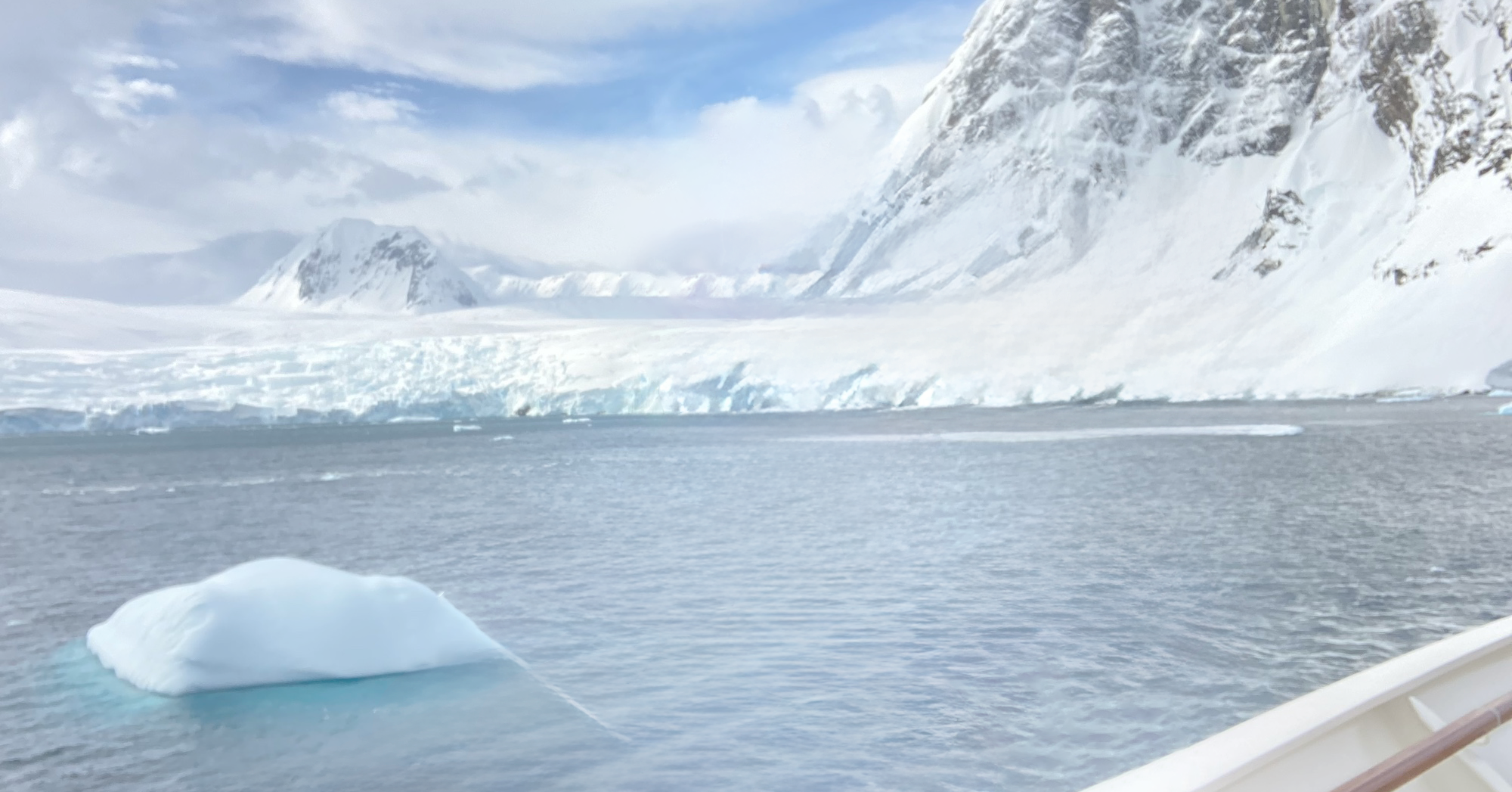
As an Antarctic traveller, you're able to help with key scientific research on cetaceans. Get involved with the Happywhale citizen science project by uploading your whale fluke pictures. This will help researchers identify different individual whales and track their migration.
Paul Clammer Guidebook Editor
The blue whale – the largest animal on Earth – is a rare but spectacular sight in Antarctica. While populations are slowly recovering, they remain one of the least commonly seen whales on expeditions as their vast roaming range and deep-diving habits make sightings extremely rare. If you do spot one, it could be one of the larger southern blue whales or the smaller pygmy blue whales.
To identify a blue whale, look for:
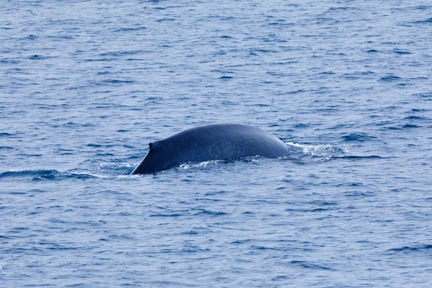
Blue whale
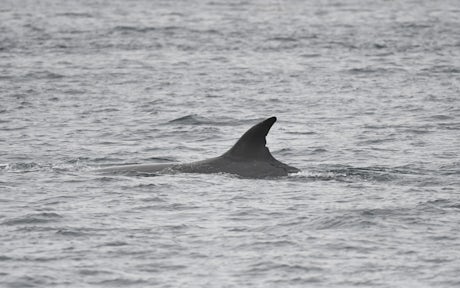
A sei whale's sickle-shaped dorsal fin
Even more elusive than blue whales, sei whales are deep-diving baleen whales that tend to stay offshore in deeper waters, making them very difficult to spot from an expedition ship. They also don’t usually interact with ships or boats. Generally, sei whales travel alone or in trios. They are similar looking to fin whales, so it’s easy to mistake them for these much more commonly sighted cetaceans.
To identify a sei whale, look for:
Southern right whales and sperm whales are another two species that inhabit Antarctic waters, but sightings are exceptionally rare. Southern right whales were heavily hunted – their slow swimming speed making them easy to catch – and the population is still recovering. Sperm whales tend to favour ice-free, deeper waters, making them unlikely to be seen near your expedition route.
The most memorable moment was humpback whales swimming under and around our zodiac, spyhopping us multiple times!! Read the full review
Travelled: March 2025
Bryan Niebanck - USA
Most memorable moment? Watching a humpback whale plunging under our zodiac! Wow... Read the full review
Travelled: March 2025
S M Kaiser Ali - Bangladesh
I expected beautiful scenery and it didn’t disappoint, but I was overwhelmed with how many whale encounters we had. I cried because I tried and paid to see whales in at least 3 different countries and saw none. The penguins are of course hilarious and made me laugh. Coming to Antarctica in March was key. Read the full review
Travelled: March 2025
Maria Lucinskas - UK
Too many memorable moments to pick from. The sheer number of humpbacks and orcas and how close they were was completely amazing.
Travelled: March 2025
William R Gilliland - USA
Most memorable moment? The amazing grouping of whales that we saw on the first day after the Drake Passage. Many humpbacks and killer whales. An amazing sight! Read the full review
Travelled: March 2025
Gary Randolph Stage - USA
We had a humpback whale come right up beside our zodiac where it stayed for about half an hour! It was so playful and curious, spyhopping to see what was going on and swimming around genuinely like it was playing with us. It was incredible! Read the full review
Travelled: February 2025
Lesley Anne McIntosh - UK
There were so many memorable moments, but if I had to choose one, having the humpback whales right next to our boat in the zodiacs and on the ship. Read the full review
Travelled: February 2025
Christine Roberts - USA
The whole trip was an unbelievable experience and a perfect honeymoon. The best part of the trip was being out in Zodiacs and seeing 20-30 humpback whales surfacing all around us.
Travelled: February 2025
David Noyes - USA
Most memorable moment? Waking up in Antarctica waters seeing whales all around the boat - literally every time I looked out a window there was another whale. It was incredible. Read the full review
Travelled: February 2025
Yvette Crabtree - USA
Most memorable moment? Watching at least 20 orcas swimming toward the ship, just below the surface. Read the full review
Travelled: February 2025
Jeff Montgomery - USA
Most memorable moment? Seeing orcas teaching their young to hunt a seal. Read the full review
Travelled: February 2025
Nurit Golan - Israel
2 humpback whales swam under and over to our zodiac, raising their heads a few times within an inch of our zodiac to check us out and listen to my husband and I talk to them, showing such sentience, consciousness and gentleness. Read the full review
Travelled: February 2025
Kit Yin Boey - Singapore
Kayaking in Charcot Bay and having a humpback whale swim up less than 20 feet in front of us, and then 20 minutes later, seeing 6-7 orcas swimming right in front of us. Words, pictures and videos cannot do that feeling justice. Read the full review
Travelled: February 2025
Mansi Parikh - USA
Most memorable moment? Seeing two humpback whales swim past me as I sat in a kayak with my wife.
Travelled: January 2025
Robert Snyder - USA
Whale watching by zodiac was amazing! And riding around so many icebergs didn’t even seem real! Read the full review
Travelled: December 2024
Cynthia Coats - USA
I am not sure how to select the best memory but it may be the humpback whale that came up to show her tail while we were in the zodiacs. The experience and the reaction we all had made me cry. I still see that moment and hear our WOW! reaction. Read the full review
Travelled: November 2024
Irma Vazquez Cabezas - Netherlands
All the excursions were great but the best was observing so many whales up close and personal. Read the full review
Travelled: February 2024
Charles Williams - USA
There was not just one memorable moment. It is all absolutely incredible. Seeing all the penguins, seals and whales. The icebergs, especially in Wilhelmina Bay made me feel like I was in the movie Avatar: The Way of Water. It was all totally amazing! Read the full review
Travelled: February 2024
Carol Forrest - USA
Just awesome! We always felts perfectly safe under the guidance of the expedition staff. I would have to say the first encounter, in heavy snow, with the humpback whales was one of the most memorable. All the excursions were done with great care for the environment and the passengers. Read the full review
Travelled: January 2024
William McClure - USA
I loved the zodiac cruises! They gave us a chance to see all the wildlife, AND ESPECIALLY THE WHALES, from a whole new point of view. Wow, the whale watching on the cruises was just the best. Love. Read the full review
Travelled: January 2024
Amy Ergle - USA
Review:

As both predators and prey, seals are key to the Antarctic ecosystem. Learn more about the five main species you’re likely to spot.
Discover More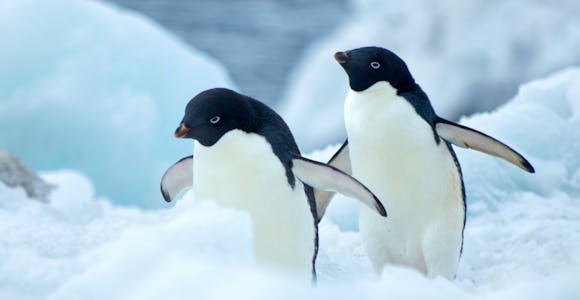
Discover the key penguins you might encounter and find out how to make the most of your time spotting these wonderful animals.
Discover More